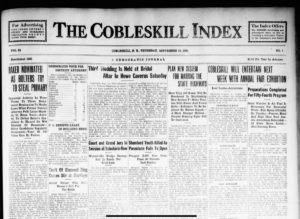This day in Mohawk Valley history: September 19, 1929
As reported in The Cobleskill Index, Otsego County, NY
PLAN NEW SYSTEM FOR MARKING THE STATE HIGHWAYS
More Than 400 Roads Will Be Numbered In Establishing New System To Make Tourists Path Easier And Travel Safer–Reflectors To Be Replaced By Button Signals–A Much Cheaper Method–Present Warning Signs Will Be Continued.
Numbering of more than 400 highways in the Empire State and the establishment of an entirely new system of highway signs is announced by David Noonan, superintendent of the state highway department.
Every state, federal and county highway is to be numbered, roads being designated from 1 to more than 400. It will be several months, however, before the maps are completed and the road guides issued. The new signs will be placed at half mile intervals throughout the road system.
”The object is to make the roads safer for automobiles, and direction finding easier,” explained Mr. Noonan, who said that the system being worked out is believed to be the best possible with those objects in view.
New illuminated signs, particularly those with reflecting buttons, are to be installed along all state roads, making them visible day and night. The present red and yellow reflectors which have been placed at dangerous points to warn traffic are to be displaced by the button signals. These will be visible at night from the reflection of automobile headlights, and, it is believed will prove much more efficient and cheaper than the reflectors which are comparatively easily broken.
New York state joins other states in the union by placing shield signs on transcontinental routes. The state roads, however, will be marked only by number signs, replacing the painted numbers on telephone poles. Junction points are to be marked with permanent metal signs, and in cases of detours, the state route will carry the route number and a detour sign throughout the detour. Directional arrows on state number route signs are to be placed at approaches to junctions, or where turns are necessary to follow a road.
The present cast iron signs, yellow background and black letters for warning signs and white backgrounds and black letters for directional signs will be continued. There are six types of warning signs not counting the black and white railroad crossing signs. The black and white directional signs are more numerous, for these are to be placed at all boundary lines, international, state, county, city and village, as well as designating signs to call attention to rivers, lakes, reservoirs, and similar points of interest, Mr. Noonan said.
One reason for establishing the button sign system instead of the reflectors, is that the reflectors, costing from $19 to $35, have been easily broken, and huntsmen and boys eager to try out marksmanship have simply ruined hundreds of them. Cast iron or other metal signs, while they be damaged, are more permanent.
Every time somebody has ruined a cast iron sign, the state has been out $10. Button signs cost about $15 each.
Just what the state spends a year for signs and traffic warning work is hard to estimate, but Mr. Noonan believes at least half a million dollars are invested in signs, while maintenance costs many thousands of dollars a year.
Source: NYS Historic Newspapers













![Detroit Publishing Co., Publisher. Erie Canal, Utica, N.Y. [Between 1900 and 1915] Photograph. Retrieved from the Library of Congress, <www.loc.gov/item/2016810887/>. Detroit Publishing Co., Publisher. Erie Canal, Utica, N.Y. [Between 1900 and 1915] Photograph. Retrieved from the Library of Congress, .](https://mohawkvalleymuseums.us/wp-content/uploads/2024/03/IMG_3599-705x561.jpeg)

